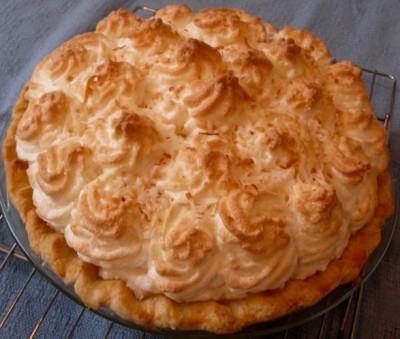Meringue can be a challenge, even for experienced bakers! This version is said to be foolproof, holding its own even in damp weather.
Meringue

Ingredients
1/3 c. water
1 T. cornstarch
4 large eggs, separated
1/2 t. vanilla
1/3 c. superfine sugar
1/2 t. cream of tartar
Directions
- Combine water and cornstarch into a small saucepan. Over medium heat, whisk constantly until the mixture thickens and becomes nearly clear. Set aside to cool completely (to room temperature).
- Meanwhile, separate the eggs and put the whites aside in a mixer bowl to come to room temperature, too. (Use a squeaky clean mixing bowl & beaters for whipping the egg whites, as any trace of fat in the bowl or on the beaters will defeat your efforts!) Set the yolks aside for another use, if desired.
- In a small bowl, combine superfine sugar and cream of tartar . Mix well.
- After the cornstarch mixture is cooled, add the vanilla to the egg whites. Begin beating with a slow speed until the whites are foamy, then increase the mixer speed to high. Add the sugar mix one tablespoonful at a time, beating well until the sugar is dissolved each time. Continue until all of the sugar is added.
- When soft peaks form, turn the mixer speed back down to medium and start adding the cornstarch mix a big spoonful at a time, blending well each time to incorporate it all.
- Raise mixer speed back to high and whip until you reach a very stiff, thick peaks. They will be firm, rigid and glossy.*
- Distribute about 2/3 of the meringue around the pie perimeter and spread toward the center, then add the remainder in the center. Be sure to seal the meringue to the crust all the way around. Decorate by making swirls and tips (dabbing the meringue with the back of a large spoon).
- Bake in a 325-degree (F) oven for 20-30 minutes until the meringue is a light brown.
*If you are baking at altitude (above 3,500 feet), stop beating when you reach the soft peak point rather than going all the way to stiff peaks. This will help ensure that your meringue can hold its form in spite of the reduced air pressure.
Baker’s Notes and Tips and Tricks
This recipe call for less sugar than some, and suggests using superfine or baker's sugar, both of which help the sugar be thoroughly dissolved in the egg whites (which reduces "weeping," those little dots of moisture collecting on the surface of the meringue). The cornstarch helps to stablize the meringue.
Sometimes it's fun to double the recipe and use a pastry bag to make nice, big swirls of meringue on the top (as shown in this photo). Just be sure to spread a layer of meringue over the entire surface first, then make your decorative swirls!
